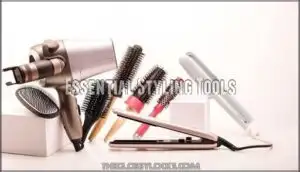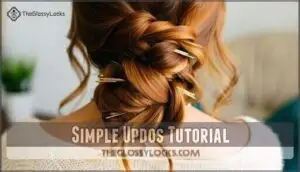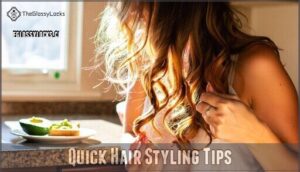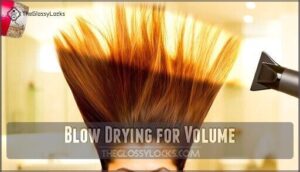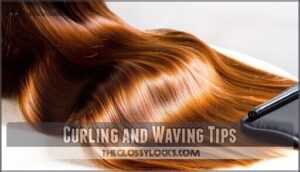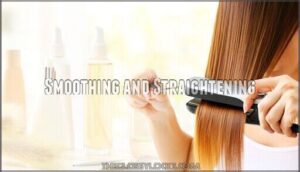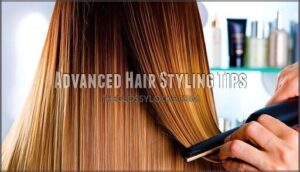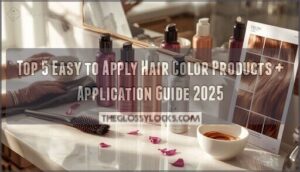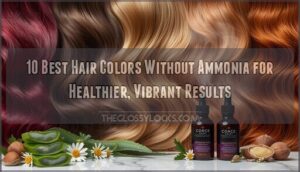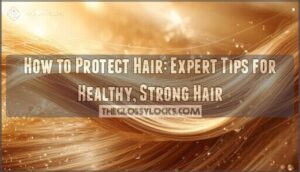This site is supported by our readers. We may earn a commission, at no cost to you, if you purchase through links.
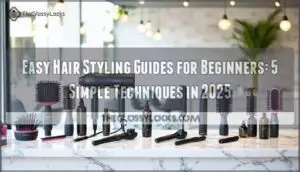
Begin with proper hair care: wash 2-3 times weekly, use lukewarm water with cold rinses, and invest in quality brushes that match your texture.
Choose heat tools with appropriate temperature settings—fine hair needs 248-302°F while thick hair can handle up to 428°F, and always apply heat protectant.
Always work in small sections for best results, and these foundational techniques reveal five game-changing styling methods that’ll have you creating salon-worthy looks with the use of proper hair care.
Table Of Contents
- Key Takeaways
- Hair Styling Basics
- Essential Styling Tools
- Easy Hairstyles Guide
- Hair Styling Techniques
- Advanced Hair Styling Tips
- Frequently Asked Questions (FAQs)
- How to learn hair styling for beginners?
- What are the 7 principles of hair design?
- What is the easiest hairstyle to learn?
- How to do simple hairstyle at home?
- How should I style my hair as a female?
- How do I prevent heat damage when styling hair?
- Can I style short hair with limited tools?
- What products protect hair during frequent styling?
- How long should heat tools stay on hair?
- Is it possible to style thin, fine hair?
- Conclusion
Key Takeaways
- You’ll identify your hair type using the Andre Walker system (straight, wavy, curly, or coily) to choose the right products and techniques that work with your natural texture instead of fighting it.
- You’ll master proper heat tool usage by applying heat protectant before styling, using appropriate temperatures for your hair thickness (248-302°F for fine hair, up to 428°F for thick hair), and working in small sections.
- You’ll establish a foundation with basic hair care by washing 2-3 times weekly, using lukewarm water with cold rinses, and investing in quality brushes that match your specific hair texture.
- You’ll create salon-worthy styles at home by practicing five fundamental techniques—sectioning, heat protection, temperature control, proper brushing, and working with your hair’s natural patterns rather than against them.
Hair Styling Basics
Before diving into specific techniques, you’ll need to understand your hair’s unique characteristics to choose the right styling approach.
Knowing whether you have fine, thick, straight, wavy, or curly hair determines which products and tools will work best for creating your desired looks, based on your hair’s unique characteristics.
Hair Type Classification
Understanding your hair type reveals styling success.
The Andre Walker system categorizes hair into four main types: straight (Type 1), wavy (Type 2), curly (Type 3), and coily (Type 4).
Each type has subtypes A, B, C based on strand thickness and texture. Fine hair feels lightweight, while thick hair appears fuller.
Identify your hair density, scalp type, and hair elasticity for proper care. Knowing your specific hair type classification is vital for choosing the right products and styling techniques to achieve styling success.
Hair Texture Analysis
How do you determine your hair texture beyond just "thick" or "fine"?
Analyzing Hair Density, Strand Thickness, and Porosity Levels reveals your natural hair texture‘s true nature.
Check Cuticle Health by running fingers along a strand—smooth indicates low porosity, rough suggests high porosity.
Test strand thickness against thread for comparison.
Understanding these factors guides proper Frizz Control methods and hair care and styling tips for all hair types.
Basic Hair Care Tips
Now that you know your hair type, proper care becomes your foundation for great styling.
Basic hair care tips aren’t complicated, but they make all the difference when creating beginner hairstyles.
Your Hair Washing routine should match your hair’s needs:
- Frequency matters: Wash 2-3 times weekly for most hair types, once weekly for curly hair
- Temperature control: Use lukewarm water and finish with cold rinses for Frizz Control
- Product selection: Choose sulfate-free shampoos and lightweight conditioners for your specific type
- Deep Conditioning: Apply Hair Masks weekly to maintain moisture and prepare hair for styling
Understanding hair care tips is essential for achieving healthy and stylish hair.
These hair care and styling tips create the perfect canvas for any look you want to achieve.
Essential Styling Tools
Having the right styling tools makes all the difference between a frustrating morning routine and effortless hair days.
You’ll want to invest in quality brushes, heat tools, and a reliable hair dryer that work specifically with your hair type and styling goals.
Having the right styling tools makes all the difference between a frustrating morning routine and effortless hair days.
You’ll want to invest in quality brushes, heat tools, and a reliable hair dryer that work specifically with your hair type and styling goals.
Brush Selection Guide
Now that you understand your hair’s unique needs, selecting the right hairbrush becomes your styling foundation.
Boar bristles work perfectly for fine hair, distributing natural oils without pulling.
Nylon bristle brushes tackle thick hair’s detangling challenges effortlessly, while paddle brushes handle everyday grooming.
Round brushes create volume during blow-drying, and choosing brush materials and bristle types that match your hair length and texture is crucial for superior results.
Understanding hair straightening tools can also help in making informed decisions about hair care and styling.
Heat Styling Tools Overview
Heat tools reveal styling possibilities when you master the basics.
Flat irons and curling irons reach 450°F, while hot air brushes offer gentler styling options.
Choose adjustable temperature settings: fine hair needs 248-302°F, medium hair 302-356°F, and thick hair up to 428°F.
Always apply heat protectant to prevent thermal damage and maintain healthy hair through proper tool maintenance.
Understanding heat styling tools is essential for achieving the desired look with the help of proper tool maintenance.
Hair Dryer Buying Tips
Selecting the right hair dryer transforms your hair care routine from frustrating to fantastic.
Look for adjustable heat control settings and ionic technology for smoother results. Ceramic dryers distribute heat evenly, while tourmaline models reduce frizz.
Always use a heat protectant before styling. Consider wattage for power—1800-2000 watts work best for most hair types.
Understanding professional hair dryer features is essential for making an informed decision when purchasing a hair dryer.
Easy Hairstyles Guide
Creating stunning hairstyles doesn’t require years of training or expensive salon visits.
You’ll discover that mastering a few basic techniques can transform your daily hair routine and boost your confidence with simple, achievable styles, which can ultimately boost your confidence.
Simple Updos Tutorial
Master these simple updos that’ll save you time and look polished.
Effortless elegance starts with mastering these time-saving updo techniques that instantly elevate your look
Effortless elegance starts with mastering these time-saving updo techniques that instantly elevate your look.
Perfect your technique with these beginner-friendly options that work for any hair length or texture.
- Braided Buns: Braid loose sections, twist into a low bun, and secure with bobby pins
- Ponytail Variations: Create height by gently teasing crown area before gathering hair
- Half Updos: Pin back front sections while leaving length flowing for effortless elegance
- Messy Chignons: Twist hair loosely at nape, tuck ends under, and pin randomly
- Pinned Back Curls: Curl hair first, then pin side sections back for romantic volume
Understanding various easy updo styles can help you create stunning looks with minimal effort.
Everyday Hair Styling Ideas
Perfect everyday hairstyles transform your morning routines into effortless styling sessions.
These beginner hair care solutions work for any hair length or texture, requiring minimal daily maintenance.
| Style | Time Needed | Best For |
|---|---|---|
| Messy high ponytail | 2 minutes | Long, fine hair needing volume |
| Sleek side part | 1 minute | Short hair, polished look |
| Braided ponytail | 3 minutes | Medium-long hair, all-day hold |
Master these simple hairdos using basic hair accessories like elastic bands and bobby pins.
These styling hacks create polished looks without complex techniques, perfect for quick fixes when you’re running late.
Quick Hair Styling Tips
Sometimes the best hair hacks come from your kitchen pantry.
Master these styling tricks for instant transformations: use dry shampoo as a texturizing spray, flip your head upside-down while blow-drying for volume, and twist damp hair into a bun overnight for effortless waves.
These quick fixes and fast styles prove that beginner hair care doesn’t require expensive tools—just smart beauty tips.
Hair Styling Techniques
Now that you’ve mastered the basics, it’s time to learn three game-changing techniques that’ll transform your hair game.
These professional methods will give you salon-quality results at home, whether you’re adding volume, creating waves, or achieving that smooth finish.
Blow Drying for Volume
Flip your head upside down while rough drying to create instant volume boost and hair lift.
Use over-direction techniques, drying sections opposite their natural fall for maximum root lift.
Apply volumizing mousse on damp hair, then section and lift with a round brush.
Finish each section with cool air to lock in your blowdried lifts and achieve that coveted lived-in volume.
Curling and Waving Tips
The Curling Wand defines waves by wrapping small sections around its ceramic barrel for maximum Curl Enhancement.
Apply wave-defining cream before using heat styling tools to improve Curl Definition and Frizz Control.
For natural Wave Patterns, wrap hair away from your face and hold for 8-10 seconds.
Hair Texturizing techniques include varying curl sizes throughout your style for dimensional results.
Smoothing and Straightening
Achieving sleek, straight hair requires the right techniques and products to protect your strands while delivering salon-worthy results.
- Apply heat protectant before flat ironing to prevent damage and maintain hair health
- Use smoothing cream on damp hair to create a foundation for frizz-free straightening
- Work in small sections with your flat iron, gliding slowly from roots to ends
Start with clean, towel-dried hair and apply a quality hair serum for extra shine and protection during the straightening process.
Using a heat protectant spray is essential for preventing damage to your hair, which is crucial for maintaining hair health and achieving salon-worthy results with frizz-free straightening.
Advanced Hair Styling Tips
Once you’ve mastered the basics, it’s time to elevate your hair game with advanced techniques that’ll transform your styling routine.
These pro-level tips will help you create salon-worthy looks at home while avoiding the most common mistakes that sabotage your efforts.
Adding Volume and Texture
Transform flat hair into show-stopping styles with strategic Volume Boosters and Root Lifting techniques.
Spray Texture Sprays at your roots, then flip your head upside down while blow-drying for instant lift.
Gentle teasing creates lived-in volume without damage.
These Hair Thickening methods and frizz management tricks give you salon-worthy results at home with the use of Root Lifting.
Styling for Different Hair Types
Understanding your hair type identification reveals the secret to effortless styling that works with your natural texture instead of against it.
Here’s how to master styling products and techniques for each hair type:
- Hair styling for fine hair: Use lightweight mousses and texturizing sprays to boost hair volume without weighing strands down.
- Hair styling for thick hair: Apply rich creams and oils through sections, focusing on frizz control and manageability.
- Hair styling for curly hair: Layer curl enhancement creams under mousse for definition while maintaining moisture.
- Hair styling for wavy hair: Scrunch with lightweight balms to enhance natural wave patterns and minimize frizz.
Common Hair Styling Mistakes
Avoid these frequent beginner mistakes that sabotage your styling efforts.
Overstyling with excessive products creates buildup and limp hair.
Daily heat damage from unprotected tools causes split ends and breakage.
Product abuse—using wrong formulas for your hair type—worsens results.
Skip harsh towel-drying that increases frizz.
These hair styling basics prevent common pitfalls in easy hairstyles.
Understanding common gel mistakes is essential for achieving perfect curls and avoiding hair damage.
Frequently Asked Questions (FAQs)
How to learn hair styling for beginners?
You’re about to discover your styling potential.
Start with your hair type—fine needs lightweight products, thick needs moisture.
Practice basic techniques like topsy-tails and half-up styles using quality brushes and heat protectants.
What are the 7 principles of hair design?
The seven principles of hair design include proportion, balance, emphasis, harmony, rhythm, contrast, and unity.
You’ll use these foundational elements to create flattering styles that complement your face shape, hair texture, and personal aesthetic perfectly.
What is the easiest hairstyle to learn?
The topsy-tail method is your easiest starting point.
You’ll simply part your hair, create a loose ponytail, and flip it through itself for an instantly polished look that takes under five minutes.
How to do simple hairstyle at home?
Studies show 73% of people struggle with basic hairstyles at home.
You’ll master simple looks using lightweight mousse for volume, a paddle brush for smoothing, and the topsy-tail method.
Start with half-up styles or ponytails—they’re foolproof beginner techniques.
How should I style my hair as a female?
First, identify your hair type—fine, thick, straight, wavy, or curly—since this determines your styling approach.
Start with simple techniques like half-up styles, gentle teasing for volume, or the topsy-tail method using lightweight products.
How do I prevent heat damage when styling hair?
Heat damage affects up to 95% of people who regularly use styling tools.
You’ll prevent damage by applying heat protectant before styling, using lower temperatures, and limiting heat styling frequency for healthier hair.
Can I style short hair with limited tools?
You’ll master short hair styling with just a few basic tools.
Use your fingers to create texture, try the topsy-tail method with just a hair tie, or add volume by gently teasing at the roots for instant lift and movement.
What products protect hair during frequent styling?
Frequent styling damages 90% of hair’s protective cuticle layer.
You’ll need heat protectants like Magical Quick Dry Potion, lightweight mousses, and setting sprays.
These products create barriers against heat damage while maintaining your style’s hold and shine.
How long should heat tools stay on hair?
Keep heat tools on hair for just 5-15 seconds per section.
You’ll prevent damage while achieving your desired look.
Moving quickly protects your strands from overheating and maintains healthy hair texture.
Is it possible to style thin, fine hair?
Like a delicate flower requiring gentle care, thin hair can absolutely bloom into stunning styles.
You’ll master volume-boosting techniques using lightweight mousses, face-framing layers, and strategic blow-drying with round brushes to create fuller-looking locks.
Conclusion
Mastering these easy hair styling guides for beginners transforms your daily routine from stressful to effortless.
You’ve learned to identify your hair type, select proper tools, and apply fundamental techniques that work with your natural texture.
Remember that consistent practice with these five simple methods—sectioning, heat protection, temperature control, and proper brushing—creates professional results at home.
Start with one technique, master it completely, then gradually incorporate others into your styling repertoire for consistently beautiful hair.
- https://www.youtube.com/watch?v=BN_tQW8ce1g
- https://nowthaticando.com/home/easy-hairstyles-for-short-hair-quick-styles-you-can-do-at-home
- https://zalahair.com/blogs/guides/6-must-have-hair-tools-at-home
- https://www.haiirology.com/blog/essential-hair-styling-tools-every-girl-needs
- https://gisou.com/blogs/blog/hair-care-routine-steps

